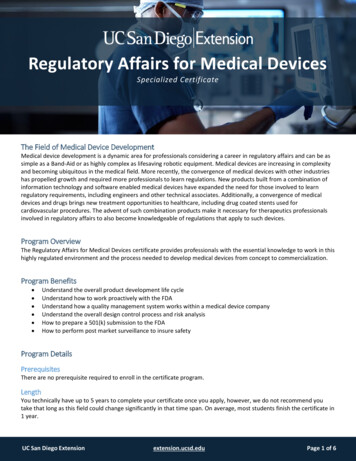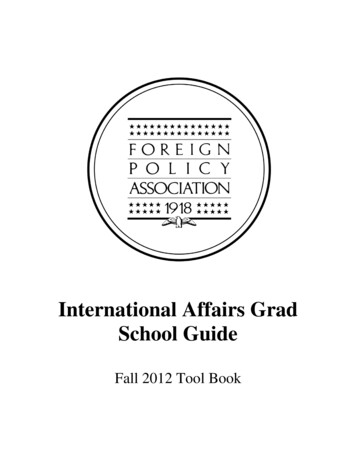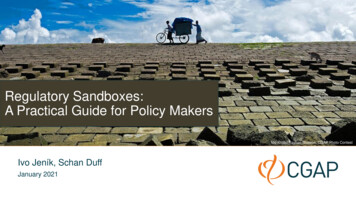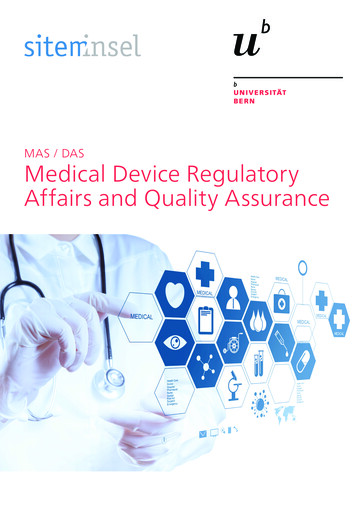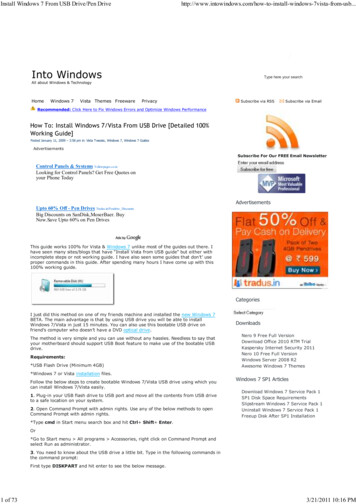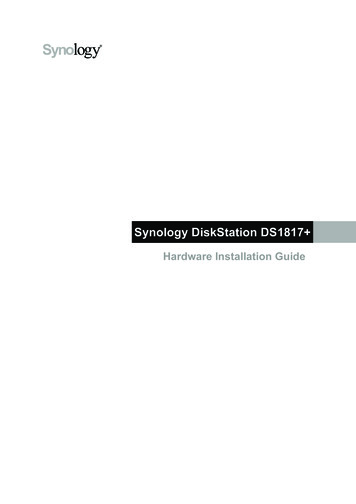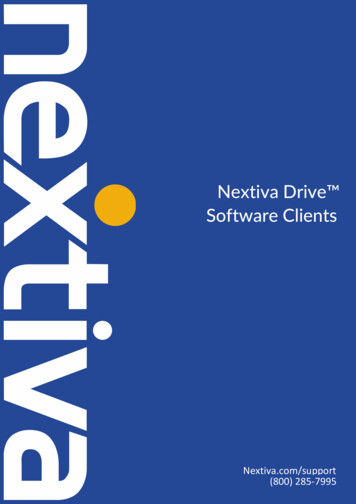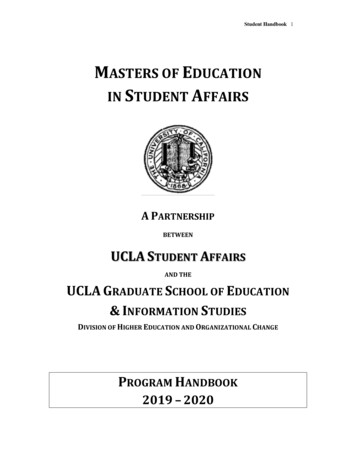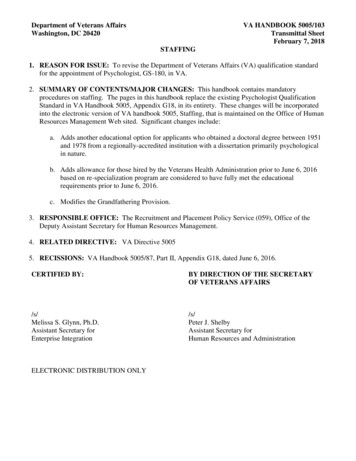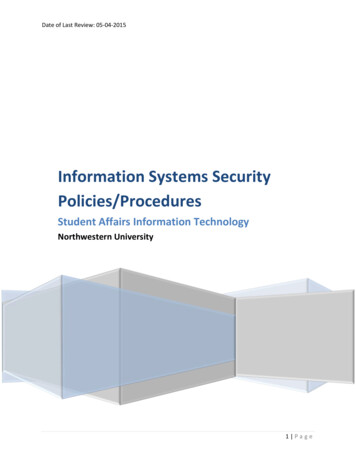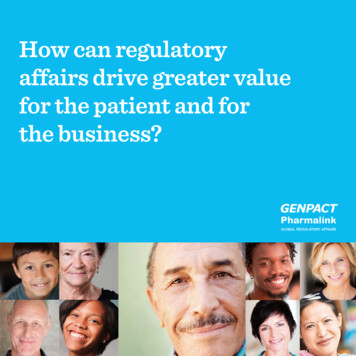
Transcription
How can regulatoryaffairs drive greater valuefor the patient and forthe business?
Exploring thekey considerations
How do youcombat therising costs ofregulatory affairs?What’s thebest operatingmodel for a trulyagile regulatoryfunction?How do youimprove regulatoryquality and speedof delivery?How can youimprove data qualityand regulatorycompliance withexisting regulatorysystems?
IntroductionIn regulatory affairs, competing demands to secure new product approvals,maintain compliance and do more with less have intensified during the lastdecade, with no sign of slowing. Scrutiny of the regulatory function continues toincrease, as does the need to control rising costs.Against this backdrop, achieving theorganization’s goal of enhanced patient value ischallenging. It raises doubts about the value andsustainability of the way regulatory affairs arestructured to do business. It questions the currentregulatory affairs operating model.An operating model optimized to meet theglobal needs of the organization would enablethe regulatory affairs function to manage theemerging and continuous demands placed uponit, shifting the perception of regulatory affairs asa cost center to being a valued asset forthe business.Desired results would include improved qualityand speed of delivery, as well as the employmentof the most valuable regulatory resources on onlythe highest-value tasks – and in the most costeffective and sustainable way.Genpact Pharmalink is the industry’s leadingglobal regulatory services company, providingregulatory support for nearly two decades to 8out of 10 of the leading life sciences companies.For over 18 years, we have built deep domainexpertise, global delivery capabilities and servicemodels that drive regulatory impact and year-onyear cost-efficiencies for our customers.Here, we consider what an optimized operatingmodel might look like and answer some of thequestions facing regulatory professionals in theglobal life sciences sector.
How do you combat the rising costsof regulatory affairs?The median cost of regulatory affairs is growing at over 10%year-on-year, driven by increasing complexity of global regulatoryrequirements, emerging markets expansion and greatercompliance challenges.These trends are set to continue forthe foreseeable future. Life sciencecompanies need a strategy tocontain regulatory costs, and addressproductivity and scalability to meetthese resource demands.Some organizations are alreadyinvestigating how to optimize regulatoryoperating models for cost reductions,and to transform the function to anasset with the capacity to innovate andexecute with speed and at scale.Outsourcing is increasingly leveraged tohelp meet these objectives. Currently,65% of life sciences companies areoutsourcing within the regulatoryfunction. This may include staffaugmentation with regulatory ‘clone’consultants or by individual projects,eliminating fixed costs of addingemployees and providing support inpeak periods of activity.Key to this is the use of “sustainableoutsourcing” in the regulatory capabilitymix. The outsourcing partner takes onresponsibility for an entire function,Outsourcing may also be undertakenby more than one service provider,adding multiple supplier managementto the function’s remit. While there mayalways be a place for these outsourcingoptions, they are a ‘piecemeal’, costlyand reactive approach to outsourcing,rather than a holistic strategy that driveslong-term, sustainable value.These models consolidate functionsacross business divisions andgeographies, and use processoptimization, such as Lean Six Sigma, ontransactional and voluminous tasks toachieve even higher levels of efficiency.Our research shows that sustainableoutsourcing of preparing CMC renewalpackages, where a process optimizationmethodology is applied, can deliversavings of 50%, as shown in Figure 1.Figure 1: Efficiency gains in preparation of CMC packages from outsourcingRenewal packagesRenewal packages per consultant144%-20%Efficiency gainsfrom optimization51722%Savings fromconsolidatingfunctions acrossbusiness divisions41228%50%100%48* Source: Cutting Edge Information; Regulatory Affairs,Safeguarding Submission Success and Product Development Strategyrole or portfolio of products. In thesemodels, use of a streamlined, focusedprocess reduces cost to the client andreleases precious internal resources forhigher value sVolume/performance t on cost structure
What’s the best operating model fora truly agile regulatory function?Some organizations have consideredhow these services need to integrate toenable business agility and, over time,outsourcing has been incorporated intothe regulatory resourcing mix in differentways, from isolated individual assignmentsand supplementary staffing through to theoutsourcing of entire functions.Early adopters have embraced operatingmodels based directly on mature modelsin other industries, where they are provenplatforms for delivering both quality andcompliance. This experience can helpdefine a business strategy that uses agilityas a source of competitive advantage anddelivers maximum impact on patient value.In these situations, organizations needan “end-to-end” outsourcing partnerto effectively manage all maintenanceactivities, except the strategy of theportfolio. This enables the client to redirectscarce strategic resources to activities andproducts critical to business growth, andwhich deliver most value to patients.Outsourcing of regulatory maintenanceactivities, or lifecycle management, isan example of this. In this model, theregulatory service partner assumesresponsibility for an entire portfolio ofolder, established products.Figure 2: Regulatory outsourcing operating modelConsulting models1 Isolated individualassignments2 Close project partnership3 Outsourced employeecloneFunctional outsourcing4 Consultant firm supportsa particular task orfunction in its entirety forthe clientImpact (quality, compliance, cost)Many organizations employoutsourcing of regulatorycapabilities for cost advantage.Focusing on the operating modelas a pivotal point for initiatingtransformational change of thefunction may yield greater resultsthan reducing costs.TimePortfolio outsourcing5 Consultant firmtakes on the supportof the entire productportfolio or a subsetthereof
How do you improve regulatoryquality and speed of delivery?In the highly competitive globalpharmaceuticals markets, regulatorystrategy and quality of submissionsare integral to achieving new productapprovals and speed to market.Further, as the time and effort needed to respondto health authorities’ inquiries escalates, designingthe operating procedures for “first-time-right”deliverables is critical to ensure timely responses.In the context of the regulatory operating model,improved quality requires robust, optimizedregulatory processes that minimize waste andrework, with a focus on value-added activities thatdeliver the key business outcomes.Genpact’s Smart Enterprise Process (SEPsm) isa unique methodology designed to optimizeregulatory, safety and compliance processes.As an assessment that uses granular data analysis,diagnostics and cross-functional benchmarks tomaximize process effectiveness, SEP is steepedin Lean Six Sigma. By focusing on identifying thecritical factors that influence delivery of regulatorybusiness outcomes, SEP targets them to achievemaximum impact, including:Tighter controls, resultingin stringent regulatorycompliance adherenceFaster time to market,creating stronger revenuegrowth opportunities andcompetitive advantageImproved capacity andproductivity to providescalability and a better,more cost-effectiveoperating model
How can you improve data qualityand regulatory compliance withexisting regulatory systems?Genpact research shows that 72% of senior executives in the lifesciences sector cite ensuring regulatory compliance as one of their threemost important challenges, outweighing the need to decrease costs at46%. Technology is a key part of the regulatory operating model.Over the last 20 years, life sciencescompanies have collectively investedmany millions of dollars in R&D IT systemsand databases to control and managetheir regulatory information. It is widelyaccepted that these investments havenot delivered to their full potential, for avariety of reasons.Users are frustrated at the lack of anend-to-end view, and management isdissatisfied at frequent compliance failuresand a lack of quality data and analytics.BusinessprocessesWith built-in capabilities for automation,global collaboration, mobility andanalytics, it will dramatically accelerate theefficiency and effectiveness of regulatoryorganizations and significantly reduceregulatory compliance failures.Submit,review,approveLabelingRegulatory gecontrolRegulatorycomplianceBatch releaseSystems ofrecordRegulatorystrategyA System of Engagement sits on top ofexisting systems of record and orchestratesbusiness processes, using a thin layer oftechnology in a flexible and adaptable wayas the business evolves.Publishing ClinicaldevelopmentEDMSCTMSSystem ofEngagementResearchThese frustrations are a result of systemsilos with no master data to connectthem. Gaps between the silos are pluggedby users creating ever more numerousand elaborate spreadsheets, “systemsof record”, while dipping in and outof various systems for process data.Regulatory professionals in local operatingcompanies are critical to the provision ofhigh-quality global regulatory data, yet theexisting R&D IT systems are rarely deployedwith this user community in mind.Currently, there is no single end-toend SAP-like platform for regulatorycompliance on the market. There is,however, a proven technology solutionthat can accelerate regulatory activitiesby taking a process-based view andembracing smart technologies.
SummaryThere is clear and compelling evidence that those companies committed torapidly evolving their business architecture in order to innovate and executewith speed and at scale will win. Regulatory organizations are under pressureto add more value to the business. A strategy that evolves the regulatoryoperating model by re-thinking the role of outsourcing and the impact oftechnology-enabled, lean processes is the key to meeting these goals.We offer regulatory support through all phases of the product lifecycle – regulatory strategy,authoring, and all aspects of established product maintenance, including submission management,publishing, health authority interaction and everything in between.Our successes to date include: Creating an advanced CMC operating model for a Fortune 500 biopharmaceuticalcompany and achieving 25% cost savings Bringing over 11,000 product licenses into compliance with global regulatory standards Delivering global CMC change management systems and processes in support of themerger of two top-10 pharmaceutical companiesAs an end-to-end service provider in regulatory affairs, Genpact Pharmalink has the global expertise,capabilities and tools to help you become an agent of change for your business and create anoptimized operating model capable of delivering enhanced patient value.
Genpact Pharmalink is the global regulatory affairs organization of Genpact.About GenpactGenpact (NYSE: G) stands for “generating business impact”. We architect the Lean DigitalSM enterprise through a unique approach based on our patented SmartEnterprise Processes (SEPSM) framework that reimagines our clients’ middle and back offices to generate growth, cost efficiency, and business agility. Our hundredsof long-term clients include more than one-fourth of the Fortune Global 500. We have grown to over 70,000 people in 25 countries, with key managementand a corporate office in New York City. We believe we are able to generate impact quickly and power Intelligent OperationsSM for our clients because of ourbusiness domain expertise and experience running complex operations, driving our unbiased focus on what works and making technology-enabled transformationsustainable. Behind our passion for technology, process, and operational excellence is the heritage of a former General Electric division that has served GEbusinesses since 1998.For additional information, visit www.genpact.com.Follow us on Twitter, Facebook, LinkedIn, and YouTube.
regulatory affairs operating model. An operating model optimized to meet the global needs of the organization would enable the regulatory affairs function to manage the emerging and continuous demands placed upon it, shifting the perception of regulatory affairs as a cost center to being a valued asset for the business.File Size: 544KB
